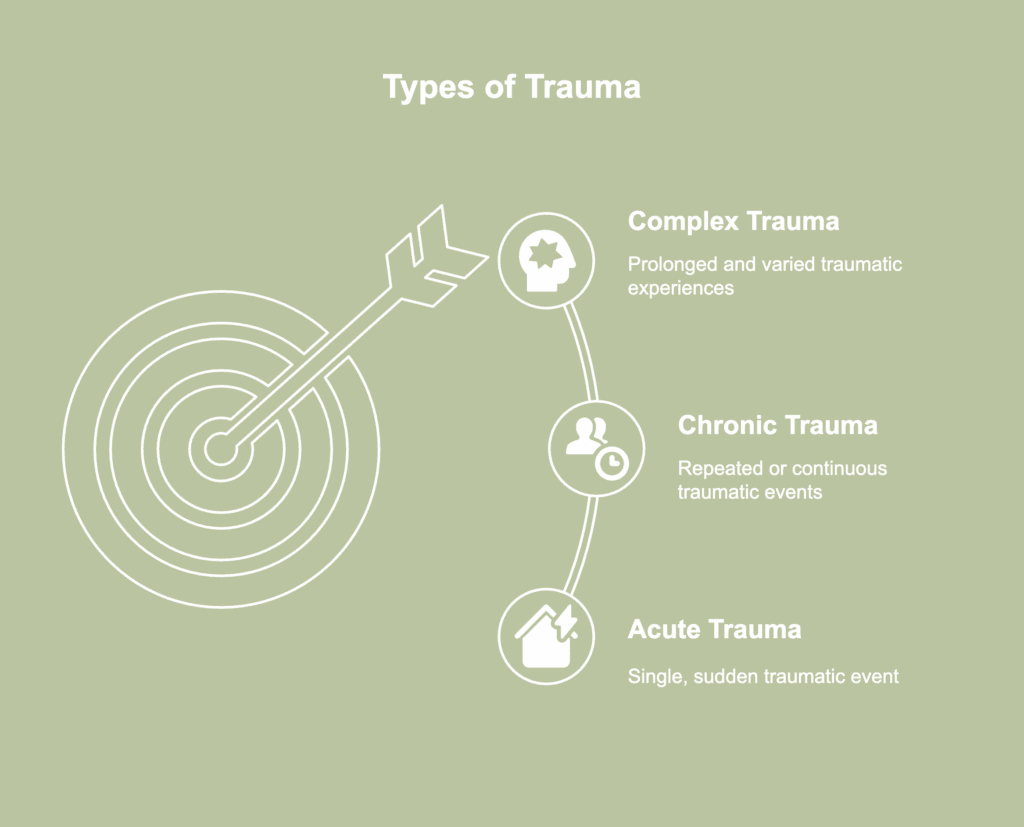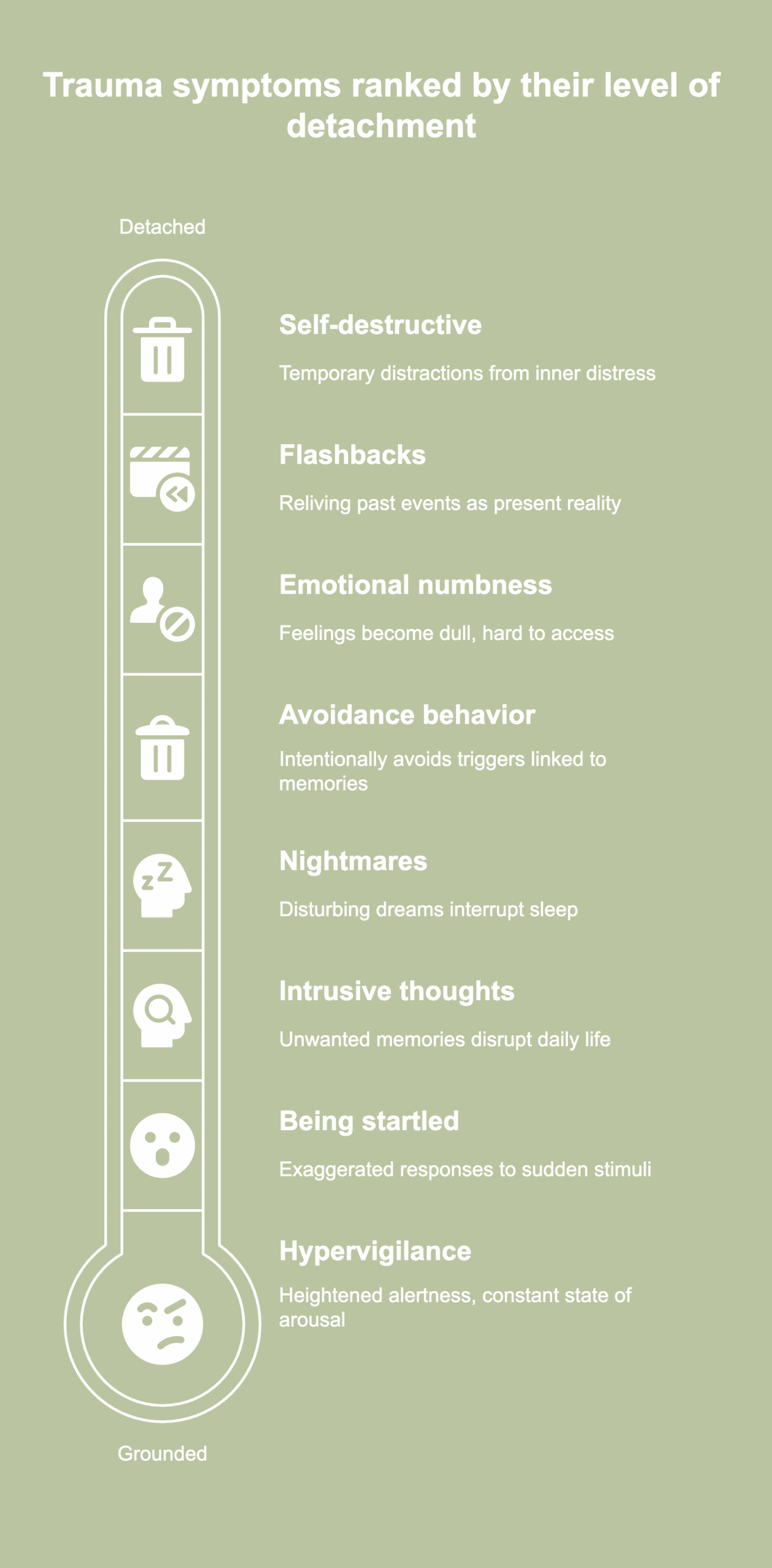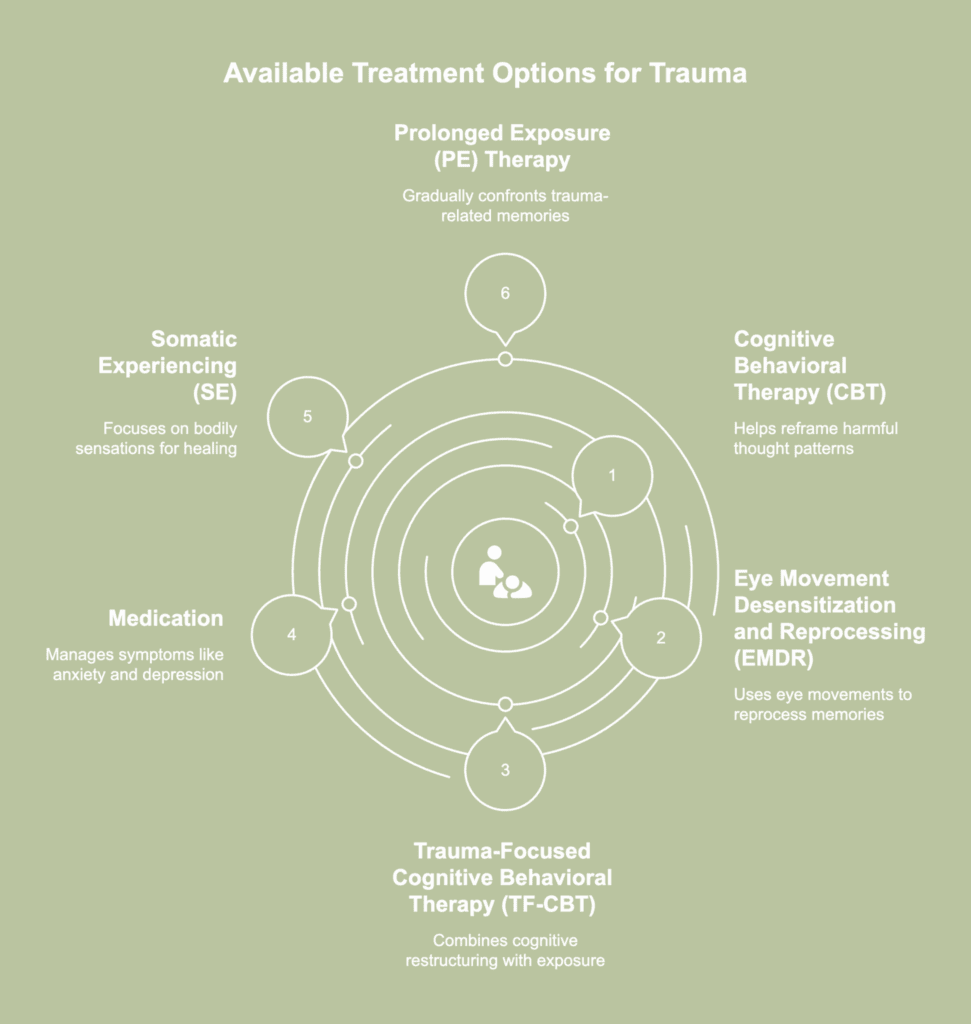Trauma: definition, types, causes, symptoms, effects, and treatment

Trauma refers to the psychological harm resulting from going through deeply distressing or disturbing events. What’s traumatic to someone is often personal, and therefore triggers vary from person to person.
The types of trauma include acute trauma, chronic trauma, and complex trauma. Each classification helps differentiate between several types of exposure.
The symptoms of trauma include intrusive thoughts, hypervigilance, emotional numbness, nightmares, flashbacks, being easily startled, avoidance behavior, and self-destructive behavior.
The effects of trauma manifest in physical ways, such as fatigue, headaches, gastrointestinal problems, increased heart rate, and sweating, as well as psychological ways, like anxiety, depression, low self-esteem, guilt, emotional numbness, shame, unpredictable emotions, and dissociation.
Available treatments for trauma include cognitive behavioral therapy (CBT), eye movement desensitization and reprocessing (EMDR), trauma-focused cognitive behavioral therapy (TF-CBT), medication, somatic experiencing (SE), and prolonged exposure (PE) therapy.
What is trauma?
Trauma describes the emotional and psychological reaction to a highly distressing or stressful incident. Usually overwhelming a person’s capacity to cope, the experience has long-lasting impacts on mental and physical well-being.
The event either occurs suddenly or continues over time, such as abuse, violence, or a natural disaster, and does not need to be life-threatening to have a traumatic impact. What makes an experience traumatic varies from person to person, depending on how stressful the situation feels and how the individual processes the event.
The disruption of one’s sense of safety, stability, and trust by trauma frequently leads to enduring shifts in emotional regulation, thought patterns, and behavior.
How common is trauma?
Trauma is extremely common. Approximately 70% of people worldwide are going to go through a potentially traumatic event at a certain point in their lives, according to a 2024 article titled “Post-traumatic stress disorder” from the World Health Organization.
As per a 2015 study by Benjet et al., titled “The epidemiology of traumatic event exposure worldwide: results from the World Mental Health Survey Consortium,” exposure to traumatic events is a widespread global occurrence, impacting 70.4% of persons, with 30.5% encountering four or more traumatic events.
The predominant events—unexpected demise of a loved one, seeing death or injury, experiencing mugging, traffic accidents, and life-threatening illnesses—constitute over half of all exposures.
What are the types of trauma?

Types of trauma are the different classifications of traumatic events according to their impact, length, and nature. The types of trauma are listed below.
- Acute trauma
- Chronic trauma
- Complex trauma
1. Acute trauma
Acute trauma refers to the emotional and psychological response following a single, sudden, and often unexpected stressful event. Such a type of trauma results from a short-lived incident causing intense fear, helplessness, or shock.
Signs of acute trauma include anxiety, difficulty concentrating, irritability, mood swings, sleep disturbances, and physical symptoms such as a racing heart or sweating. Symptoms often appear shortly after the incident and fade with time, though intensity tends to vary from person to person.
Common causes involve car accidents, natural disasters, physical assaults, or witnessing a violent act. Situations causing acute trauma often create an immediate sense of danger, triggering a strong stress response in the body and mind.
Effects include short-term emotional distress, intense fear, avoidance behaviors, or the development of acute stress disorder (ASD) when symptoms persist for days or weeks following the incident. Early intervention and support reduce the risk of ASD progressing into long-term conditions such as post-traumatic stress disorder (PTSD).
2. Chronic trauma
Chronic trauma describes extended or recurrent exposure to highly dangerous or stressful situations. Continuous exposure to adverse circumstances weakens a person’s resilience over time, upsetting one’s emotional equilibrium and sense of security.
Signs of chronic trauma include persistent anxiety, emotional numbness, flashbacks, depression, avoidance coping, and difficulty trusting others. Indications often develop gradually and become deeply ingrained, making recognition or connection to trauma more difficult.
Causes often include long-term abuse, domestic violence, ongoing neglect, repeated exposure to war or community violence, and living in unstable or unsafe environments. An individual’s susceptibility to long-term psychological harm increases when constantly exposed to stressful situations.
Effects of chronic trauma encompass increased vulnerability to PTSD and other mental health disorders, low self-esteem, trust issues, and self-destructive behaviors persisting over time.
A higher likelihood of fewer job and educational prospects is linked to chronic childhood trauma and worsened academic performance mediated by mental illness, and is further exacerbated by impediments to proper mental health care, according to a publication by Joshua Feriante and Naveen P. Sharma last updated in August 2023, titled “Acute and Chronic Mental Health Trauma.”
3. Complex trauma
Complex trauma is the psychological damage caused by multiple or repeated stressful incidents usually involving interpersonal threats or harm. Complex trauma usually begins in early life or occurs over an extended period, frequently within relationships marked by betrayal, control, or abuse.
Among the signs include strong emotional reactivity, dissociation, trouble controlling emotions, persistent guilt or shame, and challenges with relationships and identity. Such reactions mirror underlying emotional scars and disrupt daily activities, therefore making emotional balance challenging to achieve.
Causes of complex trauma commonly involve ongoing abuse or neglect, repeated exposure to domestic violence, genocide, captivity, trafficking, or abandonment by caregivers.
Effects include complex post-traumatic stress disorder (C-PTSD), severe attachment issues, self-harming behaviors, emotional dysregulation, long-term mental health challenges, and becoming trapped in a cycle of abusive relationships.
What are the causes of trauma?

Causes of trauma refer to the events, situations, or conditions triggering a distressing psychological or emotional response. The causes of trauma are listed below.
- Physical abuse: Physical abuse involves intentional acts of violence causing bodily harm, such as hitting, kicking, or choking. Victims often live in constant fear, anticipating the next incident, creating a heightened state of alertness. Over time, physical abuse erodes feelings of safety and control, especially when the harm comes from a trusted person.
- Neglect: A lack of care creates a lasting impression of unworthiness and emotional invisibility. Children exposed to neglect often develop a sense of invisibility, emotional abandonment, and disconnection from those around them. Without nurturing bonds during early development, forming secure and meaningful relationships in adulthood becomes a major challenge.
- Sexual assault: Sexual trauma results from any non-consensual sexual contact or coercion. Survivors often struggle with intense feelings of guilt, fear, and confusion, even though the fault lies entirely with the perpetrator. Trust in others and in one’s own judgment are severely shaken, disrupting relationships and personal boundaries. Nightmares, flashbacks, and hypervigilance commonly persist long after the assault has ended.
- War, conflict, or displacement: People who experience conflict often live with the sound of gunfire, the fear of arrest, or the trauma of losing loved ones. According to a 2022 editorial by Bürgin et al., titled “Impact of war and forced displacement on children’s mental health—multilevel, needs-oriented, and trauma-informed approaches,” long-term stress results from war’s deprivation of children’s emotional and physical safety, including safe housing. As observed in Ukraine where children escaped with mothers while fathers stayed behind, countless kids are split from one or both parents during flight.
- Emotional or psychological abuse: Emotional abuse includes consistent belittling, manipulation, threats, and control aimed at undermining a person’s self-worth. Victims often start questioning reality and develop a belief that mistreatment is deserved. Ongoing exposure to such cruelty fosters deep-seated shame, heightened anxiety, and a damaged sense of identity.
- Chronic illness or invasive medical treatment: Living with a serious illness or undergoing repeated medical interventions tends to be emotionally draining and traumatic. The body often becomes a source of pain and limitation, making daily life feel like a struggle. Hospital stays, diagnoses, or procedures create a sense of fear and uncertainty about survival. Psychological trauma arises not just from physical symptoms but from the emotional toll of ongoing vulnerability as well.
- Witnessing violence: Even without being directly harmed, observing acts of violence has traumatic effects. The brain often perceives danger vicariously, as if the threat were personal and immediate. People exposed to violence—whether in the home, community, or through media—experience chronic fear, emotional numbing, or aggressive behavior.
- Natural disasters: Events like earthquakes, hurricanes, or wildfires destroy homes, displace families, and end lives in an instant. Survivors often feel powerless against nature’s force, leading to lingering fear of recurrence. The experience of losing shelter, possessions, or loved ones creates both emotional and practical upheaval. A 2024 review by Eamin Z. Heanoy and Norman R. Brown titled “Impact of Natural Disasters on Mental Health: Evidence and Implications” confirmed through both direct (trauma) and indirect (life disruptions) pathways, natural catastrophes have a negative impact on mental health; PTSD (10–50%), depression (5.8–54%), and anxiety (2.2–48%) are common.
- Bullying or harassment: Ongoing verbal, physical, or online harassment fosters a toxic atmosphere, gradually wearing down self-worth. Victims frequently absorb the mistreatment, accepting harmful labels as personal truths. Over time, bullying results in social withdrawal, depression, and even suicidal thoughts. The constant humiliation and fear of ridicule make school or work feel like battlegrounds.
- Sudden loss of a loved one: Losing someone unexpectedly through death—especially in violent or tragic circumstances—leads to overwhelming grief and emotional shock. Sudden loss often creates a void, with no clear way to restore the emotional balance once shared. Numerous people struggle with denial, guilt, or anger, particularly if the loss was traumatic or avoidable.
What are the symptoms of trauma?

Symptoms of trauma refer to the reactions emerging in response to a highly stressful or distressing experience. The symptoms of trauma are listed below.
- Intrusive thoughts: Unwanted memories often return unexpectedly, replaying distressing events in vivid detail. Intrusive thoughts feel invasive, disrupting daily tasks or conversations without warning. A 2024 article by Kralj et al., titled “Intrusive thoughts and memories in adolescents with major depressive disorder or post-traumatic stress disorder” revealed nearly all PTSD group members—92.3%—reported having intrusive memories. 50% of the PTSD group reported intrusive memories on a weekly basis, and 33.3% reported thoughts lasting for more than an hour.
- Hypervigilance: A constant state of alertness develops, even in safe environments. Sounds, movements, or expressions others find harmless trigger intense fear or alarm. The nervous system stays on high alert, prepared to respond to perceived threats even in the absence of actual danger. Heightened sensitivity often leads to exhaustion and difficulty relaxing.
- Emotional numbness: Feelings become dull or hard to access, as though a barrier has formed between the individual and their emotions. Joy, sadness, love, or anger seem muted or entirely absent. Detachment acts as a defense against pain and limits the ability to connect with others. Relationships and daily life suffer due to the lack of emotional engagement.
- Nightmares: Disturbing dreams involving past trauma repeatedly interrupt sleep. Nightmares reflect exact memories or abstract symbols tied to emotional pain. Waking up in fear or confusion becomes common, often leaving lingering stress. Poor sleep quality then adds to daytime fatigue and emotional instability.
- Flashbacks: Past traumatic events resurface vividly, as if happening in the present moment. Episodes are triggered by certain sights, sounds, or smells, causing intense emotional or physical reactions. During a flashback, the surrounding environment fades away, replaced by the memory of the trauma. The experience often leaves individuals disoriented, distressed, and emotionally overwhelmed.
- Being easily startled: Sudden noises or movements often provoke exaggerated responses, even when no real threat exists. Startling easily reflects a heightened state of arousal maintained by the brain’s survival instincts. Over time, frequent reactions to minor triggers drain emotional energy and cause social discomfort. A startle response often coexists with anxiety and hypervigilance, reinforcing the body’s sense of danger.
- Avoidance behavior: Intentional efforts to avoid places, people, or conversations linked to painful memories often become a regular habit. The pattern often extends to suppressing thoughts or emotions related to the traumatic experience. Although short-term relief follows, consistent avoidance deepens fear and blocks emotional recovery. Gradually, one’s world shrinks to feel safer.
- Self-destructive behavior: Self-destructive behaviors often serve as temporary distractions from inner distress or numb overwhelming feelings. Patients with a history of trauma are more likely to engage in self-destructive behaviors, such as substance misuse, binge or restrictive eating, reckless driving, or high-risk impulsive conduct, according to chapter three of the 2014 publication from the Substance Abuse and Mental Health Services Administration (SAMHSA), titled “Trauma-Informed Care in Behavioral Health Sciences.”
What are the effects of trauma?

Effects of trauma are the long-term repercussions accompanying a traumatic or upsetting event. The effects of trauma are listed below.
- Physical effects: Physical effects of trauma include fatigue, headaches, gastrointestinal problems, increased heart rate, and sweating. Bodily symptoms often arise as the body remains in a prolonged state of stress, straining major systems over time. Disrupted sleep patterns and chronic pain further weaken resilience, making recovery more difficult. As the body and mind are closely related, taking care of physical health is essential to the healing process as a whole.
- Psychological effects: Psychological effects of trauma include anxiety, depression, low self-esteem, guilt, emotional numbness, shame, unpredictable emotions, and dissociation. Such reactions often reflect the mind’s struggle to make sense of distressing experiences and restore emotional balance. Sudden mood shifts, detachment from reality, or overwhelming self-blame disrupt everyday life and hinder personal growth.
How long does a trauma last?
A trauma lasts anywhere from several weeks to months, and in certain cases, even stretches across years. Duration depends on the intensity of the experience, the individual’s coping capacity, and the presence of a support system.
Certain people begin to feel better shortly after the event, especially with early care and intervention. Others continue to struggle long-term, especially when trauma remains unaddressed or is repeated over time.
Psychological distress does not follow a fixed timeline and resurfaces unexpectedly through triggers. Emotional recovery often unfolds gradually and requires consistent attention and effort. Although certain symptoms gradually lessen without intervention, others demand guidance from mental health professionals.
Proper resources and consistent support make the effects of trauma easier to handle, though lingering signs still persist.
What are the available treatments for trauma?

Available treatments for trauma are the therapeutic approaches and support systems meant to enable people process, manage, and heal from traumatic events. The available treatments for trauma are listed below.
- Cognitive behavioral therapy (CBT): CBT guides individuals in recognizing and confronting harmful thought patterns connected to traumatic experiences. Reframing damaging beliefs and adopting healthier viewpoints reduces anxiety and emotional distress. The structured approach encourages problem-solving and goal setting, offering a sense of control. Regular practice of cognitive behavioral therapy techniques leads to long-term emotional resilience.
- Eye movement desensitization and reprocessing (EMDR): EMDR therapy uses guided eye movements to help the brain reprocess traumatic memories. While focusing on distressing events, individuals engage in bilateral stimulation, reducing the emotional charge linked to traumatic memories. Over time, the trauma becomes less intrusive and easier to recall without overwhelming distress.
- Trauma-focused cognitive behavioral therapy (TF-CBT): TF-CBT is a specialized approach combining cognitive restructuring with exposure techniques to target trauma-related issues directly. Individuals learn to face and process traumatic memories in a safe and controlled environment. Findings of a 2020 study by Kameoka et al., titled “Effectiveness of trauma-focused cognitive behavioral therapy for Japanese children and adolescents in community settings: a multisite randomized controlled trial” corroborated the efficacy of TF-CBT in alleviating PTSD and depressive symptoms among children and adolescents in community settings.
- Medication: Certain medications, such as antidepressants or anti-anxiety drugs, help manage symptoms like panic attacks, depression, and insomnia linked to trauma. Though not considered a cure, medication promotes emotional balance, allowing better participation in therapy. A healthcare provider tailors prescriptions based on symptom severity and individual response. Medication often works best when combined with other therapeutic treatments.
- Somatic experiencing (SE): Somatic experiencing addresses trauma by focusing on bodily sensations rather than verbal recounting. Gentle awareness of physical responses creates space for healing without retraumatization. Individuals find SE grounding and restorative, especially when traditional talk therapies feel overwhelming.
- Prolonged exposure (PE) therapy: PE involves gradually confronting trauma-related memories, feelings, and situations once avoided. Through repeated and controlled exposure, emotional distress lessens over time, helping individuals regain a sense of control and reduce fear responses. A 2023 paper by Duane D. Booysen and Ashraf Kagee titled “Trauma survivors’ perceptions and experiences of prolonged exposure for PTSD at a psychology clinic” revealed people who had undergone trauma saw brief physical education as a helpful and socially acceptable form of treatment. The participants valued the clarity and containment that PE offered through its organized, goal-oriented approach. Recovery entailed a reduction in the impact of trauma, a decrease in avoidance, and a progression of life improvements.

